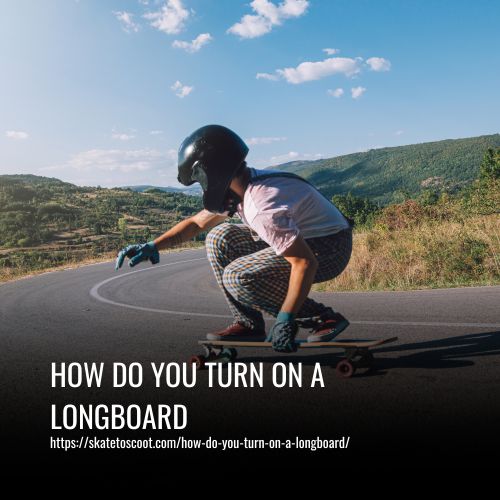As an Amazon Associate we earn from qualifying purchases.
One of the most important factors in successfully turning on a longboard is your body positioning. By shifting your weight and adjusting your stance, you can control the direction and speed of your turns. Whether you’re a beginner or an experienced rider, understanding the mechanics of turning is crucial for improving your longboarding skills.
To Turn On A Longboard, follow these steps:
- Stepping Onto Your Longboard.
- Rolling Down A Soft Incline.
- Pushing on Your Longboard.
- Stopping.
- Simple Turns.

Basic Longboard Riding Skills
Learning basic longboard riding skills is essential for riding with confidence and control. This includes pushing off, turning, and braking. Once you have the fundamentals down, you can start perfecting more advanced techniques.
Step 1: Stepping Onto Your Longboard:
- Find a smooth surface, such as a quiet sidewalk or parking lot, to place your longboard on.
- Place one foot on the deck first, either your front or rear foot according to your natural stance.
- With your front foot positioned close to the front trucks at a 45-degree angle, lift your rear foot off the ground and place it shoulder-width behind your front foot, also at a 45-degree to 90-degree angle with the deck.
- If you prefer to start with your rear foot, reverse the steps.
Step 2: Rolling Down A Soft Incline:
- Find a mild and short incline with smooth pavement.
- Start rolling while holding onto a wall, rail, or a person for support.
- As you gain momentum, focus on maintaining balance and not turning initially.
- Let the longboard naturally lose its momentum as you reach the end of the incline, then step off the board.
Step 3: Pushing on Your Longboard:
- Find a flat area with a smooth surface to practice pushing.
- Step onto the longboard and lower your rear foot to the ground by bending your front knee and lowering your hips.
- Turn your front foot to point forward on the deck while lowering your rear foot to the ground.
- Push towards the back with your rear foot to get the wheels rolling, kicking it once or twice.
- Once you gain speed, bring your rear foot back onto the deck and return both feet to a 45-degree angle.
Step 4: Stopping:
- To stop, you can either jump off the board and run it out or step with your rear foot onto the ground in front of the longboard.
- If you choose to step off, your front foot will push the board backward before hitting the ground, causing the board to stop or slow down.
- Rolling on grass or a rough surface can also be an alternative way to stop for beginners.
Step 5: Simple Turns:
- Give your longboard a slight kick push on smooth flat ground.
- As you’re rolling, press with your toes onto the front edge of the deck to make your wheels turn (toeside turn).
- Shift your weight slightly toward the direction of the turn, putting more weight onto the rail.
- Gradually shift your weight from your toes to your heels to make your wheels turn in the opposite direction (heelside turn).
- Practice controlling the amount of body weight and pressure you put onto the rail for smooth and controlled turns.
Before You Start Riding On A Longboard
To begin your longboarding journey, it’s important to choose the right longboard that suits your needs. Opt for a beginner-friendly board that ensures stability and safety. Look for a low-riding board with a decent wheelbase, which is the distance between the trucks. Drop-through or double drop boards are excellent options for beginners.
1. Invest in Safety Gear:
Safety should be your top priority when learning to longboard. To prevent injuries, especially to your wrists, elbows, and knees, it is crucial to wear protective gear. Prior to stepping onto a longboard, ensure you have knee and elbow pads, as well as wrist guards. A helmet is also highly recommended. Affordable and reliable options for protective gear include Pro-Tec elbow/knee pads, 187 Killer wrist guards, and Pro-Tec certified helmets.
2. Find Your Natural Stance:
Determine your natural stance before getting on a longboard. Your natural stance is the position where you feel most comfortable. To find it, have someone gently push you from behind while standing with your feet close together. Whichever foot you instinctively catch yourself with is your front foot in your natural stance, either left foot forward (regular) or right foot forward (goofy). Most individuals have the same natural stance for all board sports. Riding in your natural stance is essential for learning how to longboard effectively.
3. Practice Static Balancing:
Before tackling moving on a longboard, practice balancing on a stationary board. Find a grassy area or thick carpet where the wheels won’t roll. Step onto the longboard and adjust your stance, typically shoulder-width apart. Even without movement, you may find it challenging to stay on the board as it leans from side to side. To improve balance, keep your knees bent to lower your center of gravity. Utilize your arms for balance while getting comfortable with arm and leg movements on the static longboard.
Learning Intermediate Riding Skills
Learning intermediate riding skills on a longboard is an exciting step towards becoming a more skilled rider. From mastering foot braking to controlling your speed through carving, these techniques will help you gain confidence and enhance your longboarding experience. Here’s how to learn these intermediate riding skills:
1. Practice Going Faster on Your Longboard:
- Find a soft and quiet hill with a flat or inclined section.
- Ride down the hill, making small toeside and heelside turns.
- Experiment with wider and narrower stances, and shift your weight between both feet to find what works best for you.
- If you experience speed wobbles, put more weight on your front foot and make more controlled turns.
2. Learn to Foot Brake on Your Longboard:
- Balancing on your front leg (or back leg if you’re a mongo pusher), lower your opposite foot to the ground to create friction and slow down.
- Brush the ground with the sole of your shoe to increase friction and brake.
- Keep your knees close to each other for stability while your foot touches the ground.
- Remember, foot braking is most effective at moderate speeds.
3. Control Your Speed Through Carving:
- Find a slightly steeper slope with space for a 180-degree turn.
- Start heading slightly downhill, then turn slightly uphill to ride perpendicular to the slope.
- When reaching the edge of the road, do a hard turn and ride across in the opposite direction.
- Lean into your rail to make successive tight turns and control your speed.
4. Learn to Fall off Your Longboard Safely:
- Educate yourself on how to fall properly to avoid injuries.
- Tuck your arms across your upper body, land on your forearm, and roll sideways on your shoulder.
- Practice falling on a mattress before attempting it on a softer surface like thick grass.
- Consider wearing kneepads to drop to your knees and slide safely if needed.
By practicing these intermediate riding skills, you’ll become a more confident and skilled longboarder. Remember to always prioritize safety and wear appropriate protective gear while learning and riding.
Ideal Longboard for Turning
The ideal longboard for turning is one that is around 38 to 50 inches in length. This length is perfect for learning how to make tight turns and maneuver in small spaces. When choosing a longboard for turning, look for one that is “cambered” or slightly bent in the center. This type of board is great for handling difficult and sudden turns with ease.
To enhance your turning abilities, consider adding 80A-rated wheels to your longboard. These wheels offer greater control and grip on the road, making it easier to navigate tight turns. Additionally, opting for softer wheels can provide even more grip and improve maneuverability in tight spaces.
1. Preparing to Turn
Before you can start turning on a longboard, it’s important to prepare your board and yourself for optimal control and maneuverability. Here are some key steps to follow:
- Check your trucks: Ensure that your trucks, which are the metal structures underneath the longboard deck, are snug and secure. Loose trucks can make it difficult to turn smoothly and can compromise your balance. If needed, use a skate tool to tighten the kingpin nut on your board.
- Find your stance: Stand on the longboard deck with your feet shoulder-width apart. Experiment with shifting your weight clockwise and counter-clockwise to get a feel for how the board responds. This will help you determine if you can turn the longboard in the direction you want to go.
- Practice in a suitable area: It’s a good idea to choose a flat and empty space for practice, especially if you are a beginner. This will minimize the risk of accidents and allow you to focus on mastering the basic techniques of turning.
- Consider your body positioning: To initiate turns on a longboard, you’ll need to lean and shift your body weight in the desired direction. Centering your gravity over your front foot can help initiate a turn, while distributing your weight towards your back foot can help stabilize and control the board during the turn.
- Modify your trucks if needed: As you continue to practice and gain more experience, you may find that you prefer to fine-tune the responsiveness of your longboard. This can be done by adjusting the tightness of the kingpin nut on your trucks using a skate tool. For beginners, tighter trucks are generally recommended for more stability.
2. Kick-Turning for Intermediate Longboard Users
Kickturns are an advanced turning technique that allows intermediate longboard users to change directions without increasing their speed. To perform a kick turn, follow these five stages:
- Start in your typical riding position with both feet on the longboard deck and gain some momentum.
- Shift your rear foot to the end of the deck while keeping pressure on the board. This will help initiate the kick turn.
- Keep your front foot higher than the deck’s front truck and maintain pressure on the middle of the platform until you’re ready to rotate.
- Gradually apply more force on your back foot, causing the nose of the longboard to lift off the ground.
- Use your body weight, front foot, hips, and shoulders to swing the nose of the board in the desired direction. Keep your center of gravity above the center of the board to prevent falling backward or scratching the tail.
- Shift your weight back onto your front foot once your front wheels touch the ground again. This completes the kick turn and allows you to continue riding in the new direction.
Mastering kick turns requires practice and balance. By using your body weight and foot positioning effectively, you can execute smooth and controlled kick turns on your longboard.
Tips for Turning Your Longboard
Turning on a longboard requires balance, body positioning, and practice. By following these tips, you can improve your turning skills and maneuver your longboard with confidence.
1. Keep Your Weight Balanced:
- To successfully make a turn, it is essential to keep your weight evenly balanced between your feet.
- Shifting your weight too much to one side can result in loss of balance and potential falls.
- Focus on maintaining a centered position on the longboard deck.
2. Bend Your Knees:
- As you initiate a turn, remember to bend your knees slightly.
- This helps you maintain balance and control throughout the turning process.
- Keeping your knees flexed enhances stability and allows for smoother, controlled turns.
3. Lean Into The Turn:
- Leaning into the turn is crucial for successful longboard maneuvering.
- Shift your weight to the inside of the turn (opposite direction of the desired turn).
- This action helps you maintain balance and control while guiding the longboard in the intended direction.
4. Keep Your Eyes Up:
- When turning, it is essential to keep your eyes up and focused ahead.
- This helps you anticipate any obstacles or hazards on your path and react accordingly.
- Maintaining visual awareness allows for safer and more controlled turns.
5. Practice:
- Practice is key to improving your longboard turning skills.
- Find a safe and open space to practice turning.
- Take your time and gradually increase your speed and difficulty level.
- With practice, you will gain confidence, improve your balance, and master the art of turning your longboard.
Remember, turning on a longboard takes time to perfect. Be patient, stay focused on your body positioning, and enjoy the process of honing your longboarding skills. Happy riding!
FAQs
Turning on a longboard can be challenging for beginners, but with practice, it becomes easier. The level of difficulty depends on your longboarding experience and skill level.
There is no definitive answer to this question as it varies based on personal preference. However, some people find it easier to turn on a longboard due to its larger deck and trucks, which offer greater stability and control.
Yes, you can kick turn on a longboard. To do a kick turn, you need to build up some speed by riding down a small hill or on a straight path. Once you have enough speed, lift your back foot and kick the board’s tail around, facing the opposite direction. You can then ride away in a new direction.
No, learning longboarding is not difficult. It can be a lot of fun and only requires a few basic skills to get started. The level of progression depends on how far you want to take your skills. Some people stick to the basics, while others become experts who can perform tricks and advanced maneuvers.
Yes, you can perform an ollie on a longboard using the same techniques as a skateboard. To ollie on a longboard, you’ll need to jump up and flick the board with your back foot. Practice and proper timing are key to successfully executing this maneuver.
Conclusion:
Learning how to turn on a longboard is a skill that will open up a whole new world of adventure and excitement. Whether you’re carving down a hill or cruising through the city, mastering the art of turning will give you the freedom to explore and enjoy your longboard to the fullest. So, grab your board, hit the pavement, and let the turns take you to places you’ve never been before!
Amazon and the Amazon logo are trademarks of Amazon.com, Inc, or its affiliates.



